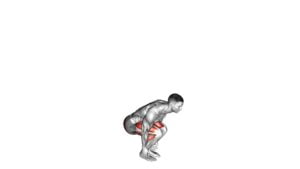Long Jump (male) – Video Exercise Guide & Tips

Are you looking to improve your long jump skills? Look no further!
Watch This Exercise Video
This video exercise guide and tips will help you reach new heights in your performance.
Learn proper warm-up and stretching techniques, plyometric exercises for explosive power, technique drills for better jump form, and strength training for increased jump distance.
Plus, get valuable tips for mental preparation and competition strategies.
Start maximizing your potential today!
Key Takeaways
- Thorough warm-up and regular stretching routine to reduce the risk of injury and improve flexibility.
- Plyometric exercises can help increase explosive power, jumping ability, speed, and agility.
- Technique drills are essential for better jump form, focusing on body positioning, movement efficiency, and landing technique.
- Incorporating strength training exercises, such as squats and plyometrics, can help increase jump distance.
Proper Warm-up and Stretching Techniques
To properly prepare for the long jump, you should always begin with a thorough warm-up and regular stretching routine. This will help prevent injuries and enhance your performance.
One important aspect of the warm-up is dynamic stretching. Unlike static stretching, where you hold a stretch for an extended period, dynamic stretching involves moving your muscles and joints through a full range of motion. This helps increase blood flow, warms up the muscles, and improves flexibility. Some examples of dynamic stretches for the long jump include high knees, leg swings, and walking lunges.
Another essential component of your warm-up routine is foam rolling. Foam rolling is a form of self-myofascial release that helps relax tight muscles and improve mobility. Using a foam roller, you can target specific muscle groups, such as the calves, quadriceps, and hamstrings, by applying pressure and rolling back and forth. This technique helps break up adhesions and knots in the muscle tissue, allowing for better movement and reducing the risk of injury.
Plyometric Exercises for Explosive Power
To develop explosive power for the long jump, incorporate plyometric exercises into your training routine. Plyometric training involves quick and powerful movements that help improve your ability to generate force and increase your overall power. Here are three key benefits of explosive power through plyometric training:
- Increased Jumping Ability: Plyometric exercises focus on explosive movements, such as box jumps and depth jumps, which can significantly enhance your jumping ability. By training your muscles to contract rapidly and forcefully, you'll be able to generate more power and propel yourself higher and farther in the long jump.
- Improved Speed and Agility: Plyometric exercises require quick movements and rapid changes in direction, which can help improve your speed and agility. By training your muscles to react and contract rapidly, you'll become more explosive and efficient in your movements, allowing you to cover more ground in less time during the approach phase of the long jump.
- Enhanced Lower Body Strength: Plyometric exercises primarily target your lower body muscles, including your calves, quads, glutes, and hamstrings. By consistently performing these exercises, you'll not only increase your explosive power but also develop stronger and more resilient leg muscles, which are essential for a powerful takeoff in the long jump.
By incorporating plyometric exercises into your training routine, you'll be able to unlock your explosive power potential and improve your performance in the long jump.
Now, let's transition into the subsequent section about technique drills for better jump form.
Technique Drills for Better Jump Form
Improve your long jump form by incorporating technique drills that focus on enhancing your body positioning and movement efficiency. These drills are designed to help you understand and improve your jumping mechanics and landing technique.
One technique drill that can be beneficial is the bounding drill. Start by standing with your feet shoulder-width apart. Jump forward, driving your knees up towards your chest and extending your arms out in front of you. Land softly on the balls of your feet, using your arms for balance. Focus on maintaining a slight forward lean and keeping your core engaged throughout the movement.
Another helpful drill is the single-leg takeoff drill. Begin by standing on one leg with your opposite leg extended slightly behind you. Jump forward, driving your knee up towards your chest and extending your arms out in front of you. Land softly on the balls of your feet, maintaining good balance. This drill helps improve your takeoff power and stability.
Strength Training for Increased Jump Distance
Increase your jump distance by incorporating strength training exercises into your routine. Strength training is crucial for improving your power and explosiveness, which are essential for a successful long jump.
Here are three key exercises to include in your strength training program:
- Squats: Squats are a fundamental exercise for building lower body strength. They target your quadriceps, hamstrings, and glutes, which are all important muscle groups for generating power in the jump. Make sure to maintain proper form and gradually increase the weight to challenge your muscles effectively.
- Plyometric exercises: Plyometrics involve explosive movements that help improve your power and speed. Exercises like box jumps, depth jumps, and bounding can enhance your ability to generate force and maximize your jump distance. Start with lower intensity exercises and gradually progress to more challenging variations.
- Nutrition for performance: Remember that strength training alone isn't enough to improve your jump distance. Proper nutrition is equally important for optimal performance. Fuel your body with the right balance of carbohydrates, proteins, and fats to support muscle growth and recovery. Stay hydrated and consume enough calories to meet your energy needs.
Tips for Mental Preparation and Competition Strategies
Get ready to enhance your mental preparation and competition strategies with these essential tips.
When it comes to excelling in the long jump, it's not just about physical strength and technique; your mental game is equally important.
One technique that can greatly improve your mental focus is meditation. By practicing meditation techniques regularly, you can learn to calm your mind, improve your concentration, and reduce anxiety before competitions. Take a few minutes each day to sit in a quiet space, close your eyes, and focus on your breath.
Another powerful tool for mental preparation is visualization exercises. Close your eyes and vividly imagine yourself executing the perfect long jump, from the approach to the takeoff and landing. Visualize every detail, including the feeling of success. This practice helps train your brain to become familiar with the movements and sensations of a successful jump, boosting your confidence and readiness for the competition.
Incorporating these meditation and visualization exercises into your training routine can give you a mental edge that can make a significant difference in your long jump performance.
Frequently Asked Questions
What Are the Most Common Mistakes to Avoid While Performing Long Jump?
When performing the long jump, it's important to avoid common mistakes that can hinder your jump distance improvements. By focusing on proper technique and form, you can maximize your potential.
Some common mistakes to avoid include incorrect takeoff timing, improper arm swing, and lack of proper knee drive. These mistakes can greatly affect your jump distance and overall performance.
How Often Should One Practice Long Jump to See Improvements in Jump Distance?
To see improvements in your jump distance, it's important to practice long jump regularly. Consistency is key. By practicing frequently, you allow your body to adapt and become more efficient in executing the technique.
Aim for at least three to four training sessions per week, focusing on proper form and technique. This won't only help you improve your jump distance but also minimize the risk of injuries.
Incorporate injury prevention exercises and long jump training techniques into your practice routine for optimal results.
Are There Any Specific Dietary Recommendations for Athletes Training in Long Jump?
To maximize your performance in long jump, it's important to consider specific dietary recommendations and nutritional guidelines.
Fueling your body with the right nutrients can enhance your strength, endurance, and recovery. By following a balanced diet that includes lean proteins, complex carbohydrates, and healthy fats, you can support muscle growth and repair, maintain energy levels, and optimize overall athletic performance.
It's crucial to consult with a sports nutritionist or dietitian to tailor your diet to your specific needs as an athlete.
Can Long Jump Be Harmful to the Knees or Joints?
Long jump is an intense sport that requires explosive power and strong joints. However, it's important to note that any sport carries the risk of knee injuries and joint damage.
When performing long jumps, the force exerted on the knees and joints can be significant. To mitigate these risks, it's crucial to focus on proper technique, warm-up exercises, and strength training to support joint health.
Always listen to your body and consult a professional if you experience any pain or discomfort.
What Are Some Effective Strategies for Dealing With Pre-Competition Nerves in Long Jump?
Feeling nervous before a competition is completely normal. But don't worry, there are effective strategies to help you manage those pre-competition nerves. One key technique is pre competition mental preparation.
This involves visualizing yourself successfully executing your long jump technique, imagining the feeling of confidence and success. Visualization techniques can help calm your nerves and boost your performance.
Conclusion
In conclusion, mastering the long jump requires a combination of proper warm-up and stretching techniques, plyometric exercises for explosive power, technique drills for better jump form, and strength training for increased jump distance.
Additionally, mental preparation and competition strategies play a crucial role in achieving success. By incorporating these tips into your training routine, you can improve your long jump performance and reach new heights in competition.
Keep pushing yourself and never stop striving for greatness!

Author
Years ago, the spark of my life’s passion ignited in my mind the moment I stepped into the local gym for the first time. The inaugural bead of perspiration, the initial endeavor, the very first surge of endorphins, and a sense of pride that washed over me post-workout marked the beginning of my deep-seated interest in strength sports, fitness, and sports nutrition. This very curiosity blossomed rapidly into a profound fascination, propelling me to earn a Master’s degree in Physical Education from the Academy of Physical Education in Krakow, followed by a Sports Manager diploma from the Jagiellonian University. My journey of growth led me to gain more specialized qualifications, such as being a certified personal trainer with a focus on sports dietetics, a lifeguard, and an instructor for wellness and corrective gymnastics. Theoretical knowledge paired seamlessly with practical experience, reinforcing my belief that the transformation of individuals under my guidance was also a reflection of my personal growth. This belief holds true even today. Each day, I strive to push the boundaries and explore new realms. These realms gently elevate me to greater heights. The unique combination of passion for my field and the continuous quest for growth fuels my drive to break new ground.



